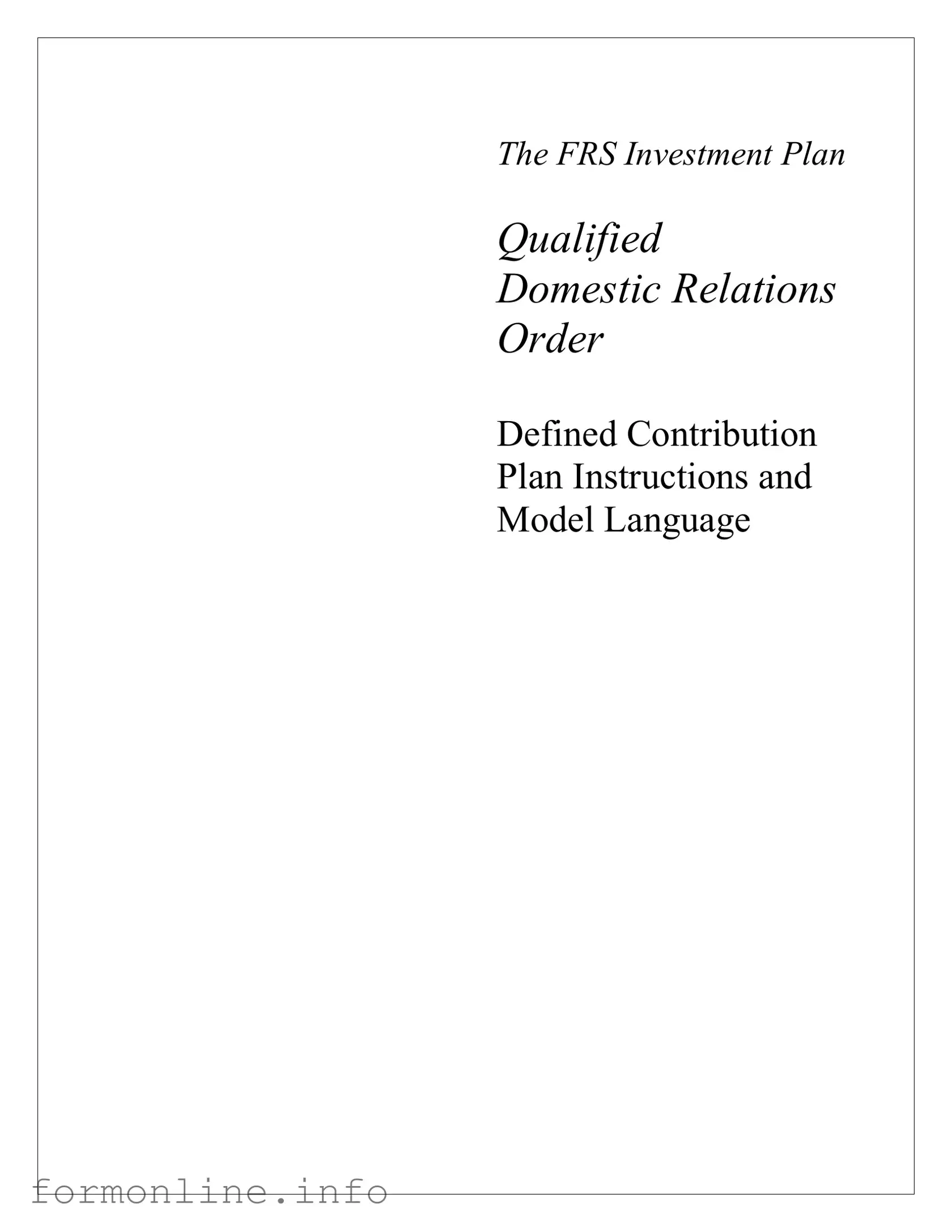The FRS Investment Plan
Qualified
Domestic Relations
Order
Defined Contribution
Plan Instructions and
Model Language
Instructions for Using the Model Language Provided
General Information
This document contains model language for a defined contribution plan Qualified Domestic Relations Order (QDRO). Pages 1 through 3 contain explanations and instructions that apply to the model QDRO language on pages 4 through 8. The explanations contain answers to most questions you may have about the model language. If you follow the instructions carefully, your domestic relations order should meet all qualifications for approval. Be sure to fill in every line wherever information is requested.
If you would like more information on the qualification process, see the Procedures document.
Since there are a number of different ways to design a QDRO and provide for division of benefits, the Plan makes no representation as to which method is best for the parties involved.
Note: Only court-certified orders can be qualified.
i
Instructions
1. Plan
In this section, you are asked to specify the defined contribution plan under which the member’s benefits are being assigned. The plan name is Florida Retirement System Investment Plan (or FRS Investment Plan).
2. Member
In this section, you are asked to identify the member whose benefits are being assigned. Fill in the following information about the member:
•Complete name
•Current mailing address (including ZIP Code)
•Social Security number
•Date of birth
3. Alternate Payee
In this section, you are asked to identify the alternate payee to whom the benefits are being assigned. Please fill in the following information about the alternate payee:
•Complete Name
•Current Mailing Address (including ZIP Code)
•Social Security Number
•Date of Birth
•Relationship to member
Note: It is acceptable to provide the addresses, Social Security numbers, and/or dates of birth on an attached document which is cross-referenced in the domestic relations order.
4. Marital History
In this section, you are asked for the dates when the participant and the alternate payee were married and divorced. Fill in the dates of marriage and divorce. If you are assigning a marital fraction, these dates will be used to determine the marital fraction
5. Definitions
The model language includes some defined terms with which you may not be familiar. These terms will be used throughout the order.
6. Benefit Payable to the Alternate Payee
In this section, you are asked to choose one of two options for specifying the dollar amount or percentage of the vested account balance to be paid, when it will be calculated, and whether any outstanding member loans and earnings/losses are to be included in the alternate payee’s benefit. Each option uses a different method: Option A uses a straight percentage method, Option B uses a dollar amount method, and Option C uses a marital fraction.
Your order cannot use a combination of these methods. Select one method only.
delivered by |
1 |
14470DCL11_09 10 75432 |
H
Option A. Straight Percentage
Please provide the following information:
•The percentage of the member’s Vested Account Balance that is to be assigned to the alternate payee
•The date the Vested Account Balance is to be calculated (known as the valuation date)
•Whether the alternate payee’s benefit will (or will not) be adjusted for earnings or losses during the period between the valuation date and the liquidation date
Option B. Dollar Amount
Please provide the dollar amount of the member’s Vested Account Balance that is to be assigned to the alternate payee.
Option C. Marital Interest
(This option can be used only if the member has previously transferred a benefit in the FRS Pension Plan (Defined Benefit Plan) to the FRS Investment Plan.
Please provide the percentage of the marital interest in the member’s vested accrued benefit that is to be assigned to the alternate payee. The member’s benefit in the Investment Plan will be valued as the date of the benefit transferred into the Investment Plan.
Note: The marital property fraction will be based on the dates provided in Section 5 of this order and on the participant’s employment history.
7. Form of Payment
This section describes the intended form of payment to the alternate payee. Plan benefits are usually paid immediately in a lump-sum cash distribution. This amount reflects any earnings and losses from the liquidation date to the date of distribution to the alternate payee.
8. Commencement
This section states when payment of benefits to the alternate payee will begin. Typically, the Plan permits payment to begin as soon as administratively possible following the determination that the order has been qualified.
9. Death Procedures
This section specifies procedures for payments of benefits under the QDRO in the event of death of either the member or the alternate payee.
10. Retention of Jurisdiction
This section outlines what is required of both parties if the Plan Administrator initially determines that the order is not qualified. It also states that the court (named earlier) expressly reserves jurisdiction over the dissolution proceeding involving the member, the alternate payee, and the member’s interest in the Plan.
11. Limitations
This section provides specific legal limits on the order.
delivered by |
2 |
14470DCL11_09 10 75432 |
H
12. Taxation
This section explains that any payments made to the alternate payee, who is a spouse or former spouse, will be subject to the appropriate federal, state, and local taxes.
13. Constructive Receipt
This section outlines what the member and the alternate payee are required to do if either receives benefits from the Plan that should have been paid to the other party.
14. Certification of Necessary Information
This section explains that the court may require the member and the alternate payee to certify in writing that the information on which this order is based is accurate.
Note: Only original court-certified orders can be qualified.
END INSTRUCTIONS—MODEL LANGUAGE FOLLOWS
delivered by |
3 |
14470DCL11_09 10 75432 |
H
STATE OF _________________ CASE # ___________________
COUNTY OF _______________
IN THE ____________________ COURT OF ________________
IN RE TO THE MARRIAGE OF:
__________________________________________
Petitioner and
__________________________________________
Respondent
Qualified Domestic Relations Order (Defined Contribution Plan)
This order creates and recognizes the existence of an alternate payee’s right to receive a portion of the member’s benefits payable under the FRS Investment Plan, which is qualified under Section 401 of the Internal Revenue Code (the “Code”). This order is intended to be a qualified domestic relations order (“QDRO”), as that term is defined in section 206(d) of the Employee Retirement Income Security Act of 1974, as amended (“ERISA”) and section 414(p) of the Internal Revenue Code of 1986, as amended (“Code”). This order is entered pursuant to the authority granted under the applicable domestic relations laws of the State of _________________________________.
1. Plan
This order applies to the FRS Investment Plan (the “Plan”)
Any successor to this plan shall also be subject to the terms of the order.
2. Member
The name, address, Social Security number, and date of birth of the member are as follows:
Name:
Address:
Social Security Number:
Date of Birth:
delivered by |
4 |
14470DCL11_09 10 75432 |
H
3. Alternate Payee
The person named as alternate payee meets the requirements of the definition of alternate payee as set forth in Section 4 of this order. The alternate payee’s name, address, Social Security number, date of birth, and relationship to the member are as follows:
Name:
Address:
Social Security Number:
Date of Birth:
Relationship to Member:
The alternate payee shall be responsible for notifying the Plan Administrator in writing of any changes in his or her mailing address subsequent to the submission of this order.
4. Marital History
Date of Marriage:
Date of Divorce:
5. Definitions
Alternate Payee—The alternate payee is any spouse, former spouse, child, or other dependent of a member who is recognized by a domestic relations order as having a right to receive all or a portion of the benefits payable under the Plan with respect to the member.
Liquidation Date—The liquidation date is the date the amount assigned to the alternate payee is transferred from the member’s Vested Account Balance to a separate account established for the alternate payee in accordance with the terms of the QDRO. An assignment as of the liquidation date assigns a portion of the member’s current Vested Account Balance.
Marital Interest—The marital interest is the member’s account balance benefit as of the Transfer Date multiplied by the following fraction:
Number of Marital Years (from the Date of Marriage to the Date of Divorce) while accruing benefits under the Plan
Years of Service during which the
member has accrued a benefit under the Plan up to the Transfer Date (the date the member’s benefit transferred into the Investment Plan)
delivered by |
5 |
14470DCL11_09 10 75432 |
H
Plan Administrator—The Florida State Board of Administration (“SBA”) is the Plan Sponsor. SBA has contracted with Hewitt Associates LLC to process domestic relations orders in accordance with the FRS Investment Plan’s QDRO requirements. Hewitt’s Qualified Order Team will conduct the qualification process.
Transfer Date— The Transfer Date is the date the member transferred a benefit from the FRS Pension Plan (Defined Benefit Plan) into the FRS Investment Plan via an accumulated benefit obligation.
Valuation Date—The Valuation Date is the date on which the member’s Vested Account Balance will be valued in order to determine the alternate payee’s designated portion in accordance with the terms of this order. Accounts are valued on a daily basis.
Vested Account Balance—The member’s Vested Account Balance is the dollar amount the member has a nonforfeitable right to receive from the Plan.
6. Benefit Payable to the Alternate Payee
(Choose Option A, Option B, or Option C. You may not choose more than one option)
Option A. Straight Percentage
The order assigns to the alternate payee an amount equal to _______ % of the member’s Vested
Account Balance under the Plan (identified in Section 1) as of ____________________ (insert
applicable Valuation Date).
From the Valuation Date to the liquidation date, the amount assigned to the alternate payee (select one):
Will be adjusted for investment earnings (gains and losses) from the Valuation Date to the date as of which the account is established for the Alternate Payee.
Will not be adjusted for investment earnings (gains and losses) from the Valuation Date to the date as of which the account is established for the Alternate Payee.
Option B. Dollar Amount
This order assigns to the alternate payee an amount equal to $_______ of the member’s Vested
Account Balance under the Plan (identified in Section 1) as of the liquidation date.
Option C. Marital Fraction
This order assigns to the alternate payee an amount equal to _______ % of the “marital interest” (as
defined in Section 4 and 5 above) in the participant’s account balance under the Plan (identified in Section 1) as of the Transfer Date.
7. Form of Payment
The alternate payee is eligible for any available form of payment under the provisions of the FRS Investment Plan.
delivered by |
6 |
14470DCL11_09 10 75432 |
H
8. Commencement
The alternate payee shall be eligible to receive payment as soon as administratively reasonable following the determination that this order is a Qualified Domestic Relations Order. In no event can the alternate payee begin his or her benefit later than April 1 following the year in which the member attains age 70-1⁄2.
9. Death Procedures
If the member predeceases the alternate payee prior to payment of the alternate payee’s assigned benefits under the QDRO, the alternate payee’s benefits will not be affected. In the event of the member’s death, the account balance, which remains the property of the member, will be payable to the member’s designated beneficiary or in accordance with Plan provisions. This order does not require the member to name the alternate payee as the beneficiary for the benefits not assigned to the alternate payee.
In case of the death of the alternate payee prior to distribution of the alternate payee’s benefits under the QDRO, the assigned benefits will be paid to the alternate payee’s designated beneficiary or, if none, in accordance with Florida law (Section 121.4501(20).
10. Retention of Jurisdiction
This matter arises from an action for divorce or legal separation in this court under the case number set forth at the beginning of this order. Accordingly, this court has jurisdiction to issue this order.
In the event the Plan Administrator determines that this order is not a Qualified Domestic Relations Order, both parties shall cooperate with the Plan Administrator in making any changes needed for it to become qualified. This includes signing all necessary documents. For this purpose, this court expressly reserves jurisdiction over the dissolution proceeding involving the member, the alternate payee, and the member’s interest in the Plan. This Order hereby vacates any previously issued QDRO in this case.
11. Limitations
Pursuant to Section 414(p)(3) of the Code and except as provided by Section 414(p)(4), this order:
(i)Does not require the Plan to provide any type or form of benefit, or any option, not otherwise provided under the Plan;
(ii)Does not require the Plan to provide increased benefits; and
(iii)Does not require the payment of benefits to an alternate payee that is required to be paid to another alternate payee under another order previously determined to be a Qualified Domestic Relations Order.
12.Taxation
For purposes of Sections 402 and 72 of the Code, any alternate payee who is the spouse or former spouse of the member shall be treated as the distributee of any distributions or payments made to the alternate payee under the terms of the order and, as such, will be required to pay the appropriate federal, state, and local income taxes on such distributions.
delivered by |
7 |
14470DCL11_09 10 75432 |
H
13. Constructive Receipt
If the Plan inadvertently pays to the member any benefit that is assigned to the alternate payee pursuant to the terms of this order, the member will immediately reimburse the Plan to the extent the member has received such benefit payments and shall forthwith pay such amounts so received to the Plan within ten (10) days of receipt.
If the Plan inadvertently pays to the alternate payee any benefit that is actually payable to the member, the alternate payee must make immediate reimbursement. The alternate payee must reimburse the Plan to the extent he or she has received such benefit payments and shall forthwith pay such amount so received to the Plan within ten (10) days of receipt.
14. Effect of Plan Termination
If the Plan is terminated, the alternate payee shall be entitled to receive his or her portion of the member’s benefits as stipulated herein in accordance with the Plan’s termination provisions for members and beneficiaries.
15. Certification of Necessary Information
All payments made pursuant to this order shall be conditioned on the certification by the alternate payee and the member to the Plan Administrator of such information as the Plan Administrator may reasonably require from such parties to make the necessary calculation of the benefit amounts contained herein.
Dated this _________ day of ____________________, ______
By the court:
__________________________________________________
Judge’s Signature
delivered by |
8 |
14470DCL11_09 10 75432 |
H



